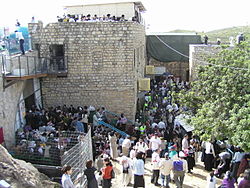Meron (Israel)
|
Meron מירון ميرون |
|
|---|---|

The tomb of Shimon bar Yochai in Meron
|
|
| Coordinates: 32°59′0″N 35°26′0″E / 32.98333°N 35.43333°ECoordinates: 32°59′0″N 35°26′0″E / 32.98333°N 35.43333°E | |
| District | Northern |
| Council | Merom HaGalil |
| Affiliation | Hapoel HaMizrachi |
| Founded | 1949 |
| Population (2015) | 898 |
Meron (Hebrew: מֵירוֹן, Meron) is a moshav in northern Israel. Located on the slopes of Mount Meron in the Upper Galilee near Safed, it falls under the jurisdiction of Merom HaGalil Regional Council. In 2015 it had a population of 898.
Meron is most famous for the tomb of Rabbi Shimon bar Yochai, and is the site of annual mass public commemoration of Lag Ba'omer.
The association of Meron with the ancient Canaanite city of Merom or Maroma is generally accepted by archaeologists. According to Avraham Negev, by the Second Temple period, Merom was known as Meron. Meron is mentioned in the Bible as the site of Joshua's victory over the Canaanite kings. In the 12th century, Benjamin de Tudela visited Meron and described a cave of tombs located there believed to hold the remains of Hillel, Shammai, and "twenty of their disciples and other Rabbis". Until at least 1931, Meron consisted of an Arab and Jewish quarter (see Meiron). The modern village of Meron was founded in 1949 on the site of the ancient settlement by Orthodox soldiers discharged after the war.
Among the local attractions are the Meron Vineyards. Meron is conducive to growing grapes for wine as a result of its 600-meter altitude and chalky soil. The vineyard was first planted in 2000 and is part of the Galil Mountain Winery, headquartered in nearby Kibbutz Yiron.
The association of Meron with the ancient Canaanite city of Merom or Maroma is generally accepted, though the absence of hard archaeological evidence means other sites a little further north, such as Marun as-Ras or Jebel Marun, have also been considered.Merom is mentioned in 2nd milleniun BCE Egyptian sources, and in Tiglath-pileser III's accounts of his expedition to the Galilee in 733–732 BCE (where it is transcribed as Marum).
...
Wikipedia

